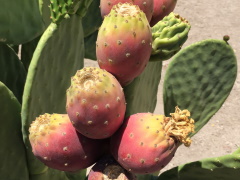Features
Water trouble
Date: 2021-03-17 09:54:11.0
Author: Jon Evans

Cactus pears.
Photo: John Cushman, University of Nevada,
Reno.
Growing the amount of bioenergy crops needed to limit global warming to just 1.5°C could have a greater impact on water supplies than allowing global warming to reach 3°C. According to new computer simulations by a team of German and Austrian researchers, the measures required to limit global warming to 1.5°C could double the number of people living under severe water stress by the end of the 21st century, compared with 2010. More encouragingly, however, these simulations also suggest that implementing sustainable water management practices could help to lessen this rise in water scarcity.
Bioenergy crops are already a central component in efforts to limit global warming, through converting them into liquid biofuels and burning them to produce electricity. Their role will only increase if the world has any hopes of limiting global warming to 1.5°C by the end of the century, the more stringent of the targets set out in the Paris Agreement of 2015.
This will require a great expansion in the amount of bioenergy crops being grown, which will create its own problems. One of the most troubling is that current biofuel feedstocks, such as maize and sugarcane, require a lot of water to grow, usually supplied via irrigation. This means that a great expansion in the amount of bioenergy crops will require a great expansion in water use, when agriculture already accounts for 70–80% of the global demand for water.
Several studies have investigated the effect on water supplies of expanding the area of bioenergy crops (see Concern over water rates), but now a team led by Fabian Stenzel at the Potsdam Institute for Climate Impact Research in Germany has conducted the most detailed computer simulations yet. They considered three different scenarios: one in which the global area for growing bioenergy crops expands substantially to 600 million hectares (MHa) by 2095, limiting global warming to 1.5°C; one in which the area increases to just 30MHa, allowing global warming to reach 3°C; and one in which the bioenergy crop area expands to 600MHa, but with sustainable water management practices.
As they report in a paper in Nature Communications, their simulations revealed that allowing global warming to reach 3°C would increase the number of people living under severe water stress by 80%, due to changes in the climate, such as reduced rainfall. But increasing the area of bioenergy crops to 600MHa would increase the number living under water stress by 100%, mainly due to the increased need for irrigation. Not only would the situation get worse in regions that already suffer from water stress, such as the Mediterranean, the Middle East and northeastern China. But water stress would extend into regions that are currently unaffected, like the east of Brazil and large parts of sub-Saharan Africa.
Introducing sustainable water management practices along with the expansion of bioenergy crops would help, reducing the increase in the number living under water stress to 60%. "Sustainable water management means both political regulation – such as pricing or water allocation schemes – to reduce the amounts of water taken from rivers, as well as on-farm improvements to make more efficient use of the water," explained team member Sylvia Tramberend from the International Institute for Applied Systems Analysis in Austria.
One potential improvement would be to replace the maize and sugarcane currently used as energy feedstocks with more water-efficient crops. In a recent paper in GCB Bioenergy, a team of US researchers led by John Cushman at the University of Nevada propose the cactus pear as a good candidate, after a five-year study of this plant and its sugar-rich fruit.
"Maize and sugar cane are the major bioenergy crops right now, but use three to six times more water than cactus pear," Cushman said. "This study showed that cactus pear productivity is on par with these important bioenergy crops, but use a fraction of the water and have a higher heat tolerance, which makes them a much more climate-resilient crop."
Nevertheless, what Stenzel and his team's computer simulations clearly show is that whatever scenario humanity ends up adopting for managing global warming, water supply is going to be an issue.
The views represented here are solely those of the author and do not necessarily represent those of John Wiley and Sons, Ltd. or of the SCI.
Displaying 2 keywords used to tag this article:
- DG6582 Mens Moncler Down Jackets Gr
- Jules Audemars-Australia Best Quali
